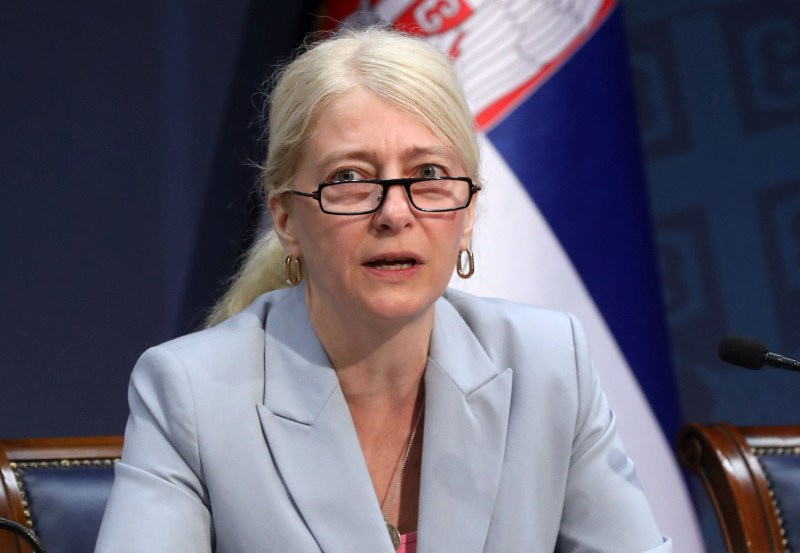- Serbia
Get to know Serbia
- Citizens
Culture and science
Health services
Pension and disability insurance
- Business
Employment
Economy
- Media
- Government
- Contact
Keep in touch
Contact form
Back
Keepin touch
Whether you have a question, comment, suggestion or any problem in the purview of the government, send us your message and we will try to respond as soon as possible. If your problem is not in our purview, we will forward your message to the relevant institution.
Q:
A:
Observation of World Tuberculosis Day in Belgrade
Belgrade,
23 March 2007
Serbian State Secretary at the Ministry of Health Nevena Karanovic said today that the World Health Organisation (WHO) has declared tuberculosis (TB) a global health issue because every year over 8 million people become ill with this disease and around 2 million die of it, mainly in developing countries.
A press conference was held regarding the observation of the World Tuberculosis Day on March 24, at which, besides Karanovic, other participants were Head of the World Health Organisation’s (WHO) office in Serbia Dorit Nitzan, coordinator of the project “Control of Tuberculosis in Serbia” Natasa Lazarevic-Petrovic, President of the Serbian Committee for Tuberculosis Gordana Radosavljevic-Asic and Secretary General of the Serbian Red Cross Vesna Milenovic.
Karanovic said on the occasion that the WHO has defined a strategy titled Directly Observed Treatment Strategy (DOTS) – short regimen as an organisational framework for fighting tuberculosis in all countries of the world.
She explained that the strategy is based on five principles such as the obligation of the government to support antituberculosis programmes in the country, the detection of TB through saliva analysis as well as the directly observed treatment by standardised therapeutic regimes.
Karanovic further elaborated that the DOTS is based on regular supply of quality antituberculosis drugs and standardised system of models for registering and reporting on the disease.
According to Karanovic, the basic aims of the programmes of tuberculosis control in the world are the detection of at least 70% cases of tuberculosis bacillus patients and curing a minimum of 85%, while the ultimate aims are reduction of the fatality rate, reduction of the rate at which disease develops and its spread, as well as prevention of the development of resistance to first-line antituberculosis drugs.
Karanovic recalled that within the framework of the Ministry of Health, the realisation of the four-year project “Control of Tuberculosis in Serbia”, which is being financed with a donation by the Global Fund to Fight AIDS, Tuberculosis and Malaria, began on December 1 2004.
The aim of this project is to reduce the number of infected by adequate medical treatment, she said and specified that there are currently 32 persons infected with tuberculosis for 100,000 inhabitants. She added that the Roma are the most vulnerable due to unhygienic settlements, as well as refugees in collective centres and prison inmates.
Nican said that according to the latest data of the World Health Organisation from 2005, there were 445,000 cases of tuberculosis and 66,000 deaths in the European region, of which almost three fourths were recorded in Kazakhstan, Romania, Russia, Turkey, the Ukraine and Uzbekistan.
Radosavljevic-Asic reiterated that tuberculosis is a contagious disease that is spread through the air and that each untreated person treated infects 10 to 15 people per year on average.
The theme of this year's World Tuberculosis Day is "Tuberculosis in One Place - Tuberculosis Everywhere", and in Serbia that day will be observed under the slogan "Get treated in the right way, fight tuberculosis".
Karanovic said on the occasion that the WHO has defined a strategy titled Directly Observed Treatment Strategy (DOTS) – short regimen as an organisational framework for fighting tuberculosis in all countries of the world.
She explained that the strategy is based on five principles such as the obligation of the government to support antituberculosis programmes in the country, the detection of TB through saliva analysis as well as the directly observed treatment by standardised therapeutic regimes.
Karanovic further elaborated that the DOTS is based on regular supply of quality antituberculosis drugs and standardised system of models for registering and reporting on the disease.
According to Karanovic, the basic aims of the programmes of tuberculosis control in the world are the detection of at least 70% cases of tuberculosis bacillus patients and curing a minimum of 85%, while the ultimate aims are reduction of the fatality rate, reduction of the rate at which disease develops and its spread, as well as prevention of the development of resistance to first-line antituberculosis drugs.
Karanovic recalled that within the framework of the Ministry of Health, the realisation of the four-year project “Control of Tuberculosis in Serbia”, which is being financed with a donation by the Global Fund to Fight AIDS, Tuberculosis and Malaria, began on December 1 2004.
The aim of this project is to reduce the number of infected by adequate medical treatment, she said and specified that there are currently 32 persons infected with tuberculosis for 100,000 inhabitants. She added that the Roma are the most vulnerable due to unhygienic settlements, as well as refugees in collective centres and prison inmates.
Nican said that according to the latest data of the World Health Organisation from 2005, there were 445,000 cases of tuberculosis and 66,000 deaths in the European region, of which almost three fourths were recorded in Kazakhstan, Romania, Russia, Turkey, the Ukraine and Uzbekistan.
Radosavljevic-Asic reiterated that tuberculosis is a contagious disease that is spread through the air and that each untreated person treated infects 10 to 15 people per year on average.
The theme of this year's World Tuberculosis Day is "Tuberculosis in One Place - Tuberculosis Everywhere", and in Serbia that day will be observed under the slogan "Get treated in the right way, fight tuberculosis".
-
 Belgrade, 22 January 2025
Belgrade, 22 January 2025Egypt one of Serbia’s closest partners on international stage
-
 Belgrade, 9 July 2024
Belgrade, 9 July 2024Support for 104 associations in diaspora that preserve Serbian language, culture
-
 Belgrade, 15 April 2024
Belgrade, 15 April 2024Competition for StarTech grants open until 31 May
-
 Belgrade, 2 October 2023
Belgrade, 2 October 2023Serbia respects Resolution 1244 and will do everything to preserve peace
-
 Belgrade, 13 September 2023
Belgrade, 13 September 2023Day of Serbian Unity to be celebrated outside borders of Serbia, Republika Srpska for the first time
-
 Belgrade, 8 August 2023
Belgrade, 8 August 2023RSD 24.2m in state aid paid out to citizens affected by storm
-
 Belgrade, 17 June 2023
Belgrade, 17 June 2023Belgrade is doing everything to preserve peace in Kosovo and Metohija
-
 Belgrade, 15 June 2023
Belgrade, 15 June 2023Slovenia will continue to support Serbia on its way to EU
-
 Belgrade, 5 May 2023
Belgrade, 5 May 2023Emergency measures, tightening of conditions for possessing weapons
-
 Belgrade, 3 May 2023
Belgrade, 3 May 2023Three days of mourning in Serbia over tragedy at Vladislav Ribnikar primary school

